Summary The Mara veterinary unit was involved in a number of activities including relocation of a stray female buffalo from Mara Shimo to Ol Choro-Oiroua conservancy, treatment of 3 wounded elephants in Olmorijoi (Lemek), Mara North conservancy and Naiboshio conservancy within the Mara ecosystem
Summary
The Mara veterinary unit was involved in a number of activities including relocation of a stray female buffalo from Mara Shimo to Ol Choro-Oiroua conservancy, treatment of 3 wounded elephants in Olmorijoi (Lemek), Mara North conservancy and Naiboshio conservancy within the Mara ecosystem. All the veterinary activities went on successfully during the month as reported below.
Relocation of a female buffalo from Mara Shimo farm to the neighboring Ol-Choro-Oiroua Conservancy, Mara.
This was a case of a female buffalo which had broken through the fence and got into a wheat plantation called Mara Shimo farm in the northern part of Mara ecosystem. It took refuge in a small bushy area near the offices and residential quarters of the farm. The buffalo used to get out from the bush to graze on the wheat farm at night then return to the thickets at dawn. It had become a threat to the farm workers who usually move on foot within the farm during the day and night. The farm manager then contacted the KWS Mara veterinary unit to help move the animal to a safer place in the nearby Ol Choro-Oiroua wildlife conservancy to ensure safety of the animals and workers in the farm. The buffalo was flushed out from the thicket by vehicles during the day and darted in the open wheat field using 5mgs of etorphine hydrochloride combined with 30mgs of xylazine hydrochloride from a vehicle. The immobilized buffalo was then lifted onto a tractor manually by people using ropes and hand and driven to Ol-Choro-Oiroua conservancy.
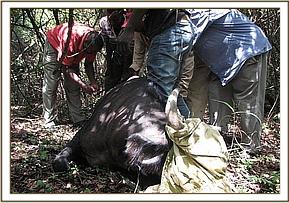

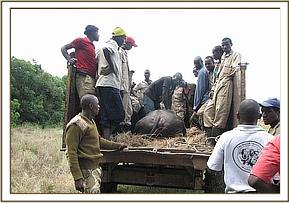
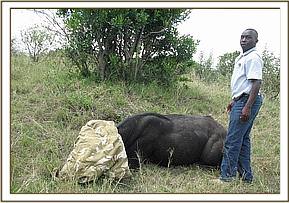

Revival from anaesthesia
After transportation, the buffalo was safely offloaded from the tractor and revived from anaesthesia using 24mgs of diprenorphine hydrochloride combined with 5mgs of atipamezole Hcl administered through the jugular vein. It rose up safely and joined a nearby herd in Ol-Choro-Oiroua after a successful relocation.
Treatment of a wounded male elephant in Olmorijoi area of Lemek.
This was a case of a sub-adult male elephant which had an infected wound on the left lateral side of the abdomen in Olmorijoi area within the Mara ecosystem. The wound was much infected with a lot of necrotic debris and pus oozing out from the opening. The elephant was in deep pain, weak and isolated, it could barely move. The cause of the injury was not known but it was suspected that the animal could have been shot by an arrow-head while being chased out of the homesteads around or crop farms nearby. The elephant was sighted by the KWS rangers in Lemek and scouts from Mara North conservancy who immediately informed the vet to attend to it. It was under a great pain and preferred resting under tree most of the time. It also had the risk of developing peritonitis and septiceamia that could easily lead to death.
Chemical immobilization, examination and treatment
The elephant was dart using 15mgs of etorphine Hcl combined with 3000 i.u on the right thigh. The drug took effect after about 7 minutes and it became recumbent. The wound was examined for the presence of any foreign material but there was none, it was then pressed and cut open to drain all the pus and necrotic debris completely. The wound was later cleaned with a lot of water and gauze swabs removing all the mud, maggots and loose tissue debris. It was also probed using long tissue forceps in an attempt to find out how deep it penetrated into the tissues. The wound was also cleaned and debrided using 10% hydrogen peroxide draining all the accumulated pus and necrotic tissue debris, then treated using a topical application of a tincture of iodine and oxytetracycline spray. Further treatments by intramuscular administration of long-acting Amoxycillin (Betamox) antibiotics and flunixin meglumine were provided.



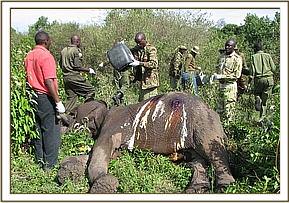

Revival of anaesthesia
After treatment, the elephant was revived from anaesthesia using 48mgs of diprenorphine hydrochloride administered through the superficial ear-vein. It was to be monitored closely by the KWS rangers at Lemek out-post who would then report the progress to the vet in case the elephant required further treatment.
Prognosis
The prognosis was poor due to higher chances of the elephant developing septiceamia and peritonitis which could easily lead to death.
Treatment and removal of arrow-head from male elephant in Mara north conservancy in Masai Mara.
This was a case of an adult male elephant which had an infected wound and a large pedunculated swelling on the left part of the abdomen in Mara North conservancy. However, the elephant was in a stable condition in a herd of 4 bulls in the open plains. It was very much suspected that an arrow-head got detached and remained in the abdominal muscles causing constant irritation and swelling. Chemical immobilization, examination and treatment The elephant was darted from a vehicle using 18mgs of etorphine Hcl combined with 5000 i.u on the left thigh. The drug took effect after about 6 minutes and it went down on lateral recumbency. The swelling was then pressed and cut open to drain all the pus and necrotic debris completely. It was later probed by a long tissue forceps and a small arrow-head with two hooks on each side was retrieved from the wound. The injury was then cleaned with a lot of water and gauze swabs removing all the pus and necrotic tissues. The wound was also cleaned and debrided using 10% hydrogen peroxide draining all the accumulated pus and necrotic tissue debris, then treated using a topical application of a tincture of iodine and oxytetracycline spray followed by intramuscular administration of long-acting Amoxycillin (Betamox) antibiotics and flunixin meglumine were provided.
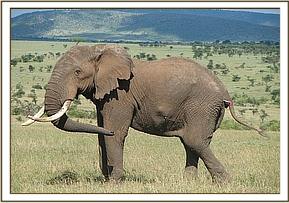
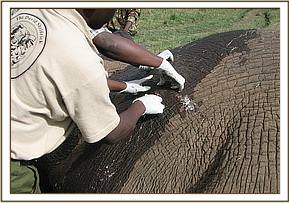

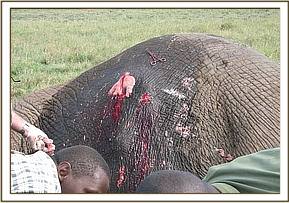


Prognosis
The elephant was revived from anaesthesia using 48mgs of diprenorphine hydrochloride administered through the superficial ear-vein. Prognosis was good after removal of the arrow and treatment of the resulting traumatic injury.
Euthanasia of an injured male elephant in Naiboshio conservancy in Mara ecosystem. This was a case of an adult male elephant which was not able to move due to severe injury on the left hind leg. The bull was accompanied by 8 other elephant bulls in the area. It was suspected that it had a fracture of one of the bones of the hind leg. Chemical immobilization and examination The elephant was darted from a vehicle using 18mgs of etorphine Hcl combined with 1500 i.u on the left thigh. The drug took effect after about 7 minutes and it went down on lateral recumbency. The leg was then physically examined by palpation and flexing of the joint to determine the cause of lameness. The elephant had an extensive cellulitis on the foot-pad of the left hind leg. The entire foot pad had already peeled off leaving a raw necrotic wound covering the entire circumference of the foot. Some of the digital bone and tendons were already exposed leading to severe tendon/ligaments inflammation and osteomyelitis. All these resulted to intensive pain and inability to move.
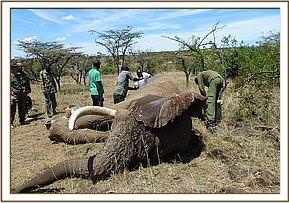
Prognosis
The elephant had no chances of recovery from the injuries and infections on the affected foot. It was then euthanized using a single gun-shot through the brain to relieve it from endless pain.
Postmortem examination
Postmortem revealed a mid-shaft fracture of the left femur bone which could not be fixed by conventional methods due to massive weight of the elephant.
Acknowledgements
Kenya Wildlife Service (KWS) acknowledges the continous support of the David Sheldrick Wildlife Trust towards provision of wildlife veterinary services in Masai Mara ecosystem this has significantly contributed to the general wildlife health and conservation in the Mara ecosystem. We also acknowledge the support of the KWS rangers and staff from Masai Mara National Reserve, Mara North conservancy, Naboishio conservancy and the surrounding community-owned wildlife conservancies for continuous support and reporting of wildlife incidences requiring veterinary intervention in the Mara ecosystem.
Report by: Dr. Domnic Mijele